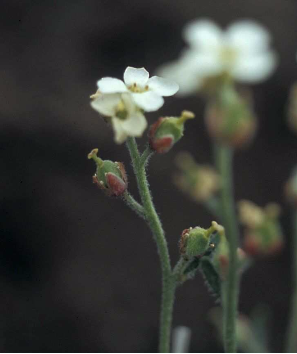 A tiny white-flowered plant that only grows in one place in the world—on Cape Bathurst Peninsula and Baillie Island—might be one of the first species in Canada’s Far North to go extinct as a result of the effects of climate change. A new plan, developed with data from the NatureServe Network, could change the future of this species and help preserve an important piece of natural history.
A tiny white-flowered plant that only grows in one place in the world—on Cape Bathurst Peninsula and Baillie Island—might be one of the first species in Canada’s Far North to go extinct as a result of the effects of climate change. A new plan, developed with data from the NatureServe Network, could change the future of this species and help preserve an important piece of natural history.
The hairy braya (Braya pilosa) is a species of mustard that lives along a desolate stretch of coastline above the Arctic Circle. It can only grow in very dry and bare soil and cannot easily expand its range. As the warming climate melts ice in the Beaufort Sea, the shorelines are eroding—and the plant’s habitat is disappearing. Consequently, hairy braya is a globally-imperiled species (NatureServe global status: G2 Imperiled) and is classified as Endangered by the Committee on the Status of Endangered Wildlife in Canada.
"I think it would be tragic to see it go,” said Jim Harris, a professor at Utah Valley University. He says the threatened species adds to the evolutionary puzzle of geology, glaciation in the North, and the territory's history. "Braya pilosa is part of that. It's part of the story."
“Shorelines are eroding at a rate of 10 meters per year, and hairy braya are often found about 50 meters from shore,” says NatureServe Network scientist Bruce Bennett, coordinator of the Yukon Conservation Data Centre. “That trajectory is not very good for this species.”
A group of collaborators, including Bennett and other NatureServe Network Program staff at the Northwest Territories (NWT) and Yukon Conservation Data Centres, developed the science that led to a plan to ensure survival of the plant for the next century. Bennett and other scientists went to the Arctic Circle to gather data on the plant. Information from their extensive field surveys were central to assessing the status of the species. This led to the Hairy Braya Recovery Strategy, released in March 2016 as the first recovery strategy developed and approved under the Species at Risk (NWT) Act. The goal of this strategy: to ensure survival of hairy braya in the wild for at least the next 100 years. Seed collection, plant propagation, and population and habitat monitoring among the key means by which this rare plant can yet persist in the Far North.
The government of the Northwest Territories estimates there are 15-20,000 plants left. With this new plan in place, and with ongoing scientific monitoring from the NatureServe Network, this part of Canada’s natural history has a better chance of surviving and even thriving.